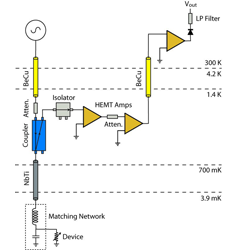This project is part of a collaboration with the group led by Andrew Sachrajda at the National Research Council of Canada (NRC). The NRC group is interested in single-shot readout of electron spins in quantum dots and its potential use in the field of quantum information processing.
The goal is to readout the state of a device at speeds of tens or maybe hundreds of megahertz. At these frequencies, the sensitivity of the readout is not limited by 1/f noise. The difficulty lies with the capacitance of the cabling that connects the device to the room temperature electronics. This capacitance and the high resistance (~50 kΩ) of the device combine to produce an RC time constant that limits the readout speed to approximately 1 MHz. This bandwidth problem is solved by transforming the device resistance close to the 50Ω characteristic impedance of the cabling and by using high-speed amplifiers with 50Ω impedances. The parasitic capacitance of the cables is then unimportant and the device can be readout at speeds determined primarily by its intrinsic capacitance.
To readout the state of the device, we make use of the fact that its impedance is a function of its state. We measure the device impedance by measuring the power reflected by the RLC circuit composed of the device and the impedance transformer. Using a signal generator at room temperature, we launch a radio-frequency signal at the resonance frequency of the impedance transformer through beryllium-copper coax to a directional coupler that is heat sunk to the 1.4 K stage of the dilution refrigerator. The coupler directs the signal through niobium titanium coax to the resonant circuit on the mixing chamber, the stage of the fridge capable of reaching 3.9 mK. The signal reflects off of the resonant circuit and travels back to the directional coupler where it is this time sent to the input of an isolator and then on to the input of a cascade of two High Electron Mobility Transistor (HEMT) amplifiers that are thermally anchored to the 1.4 K stage. The isolator attenuates noise produced by the HEMT amplifiers but does not attenuate the signal reflected off of the resonant circuit. The signal is further amplified at room temperature before it is amplitude demodulated by a diode and a low pass filter and finally captured by a digital oscilloscope.

High frequency readout circuit